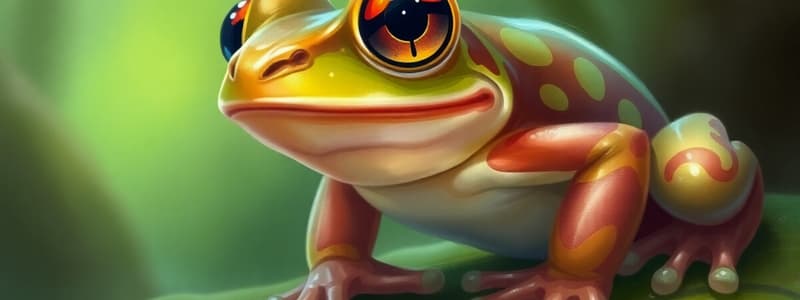Podcast
Questions and Answers
Which feature is primarily associated with frogs?
Which feature is primarily associated with frogs?
- Horns
- Feathers
- Moist skin (correct)
- Scales
What is a common habitat for frogs?
What is a common habitat for frogs?
- Tall mountains
- Arid deserts
- Freshwater environments (correct)
- Open grasslands
Which of the following best describes the diet of frogs?
Which of the following best describes the diet of frogs?
- Mainly carnivorous, eating insects (correct)
- Exclusively plant-based
- Only detritivorous
- Primarily herbivorous
What is the primary method by which frogs reproduce?
What is the primary method by which frogs reproduce?
What adaptation helps frogs in their environment?
What adaptation helps frogs in their environment?
Flashcards
Amphibian
Amphibian
A type of animal that lives both in water and on land, like frogs.
Tadpole
Tadpole
The larval stage of a frog, a small, aquatic creature with a tail.
What are frogs' legs used for?
What are frogs' legs used for?
They are used for jumping, swimming, and catching food.
What do frogs eat?
What do frogs eat?
Signup and view all the flashcards
What's special about a frog's skin?
What's special about a frog's skin?
Signup and view all the flashcards
Study Notes
General Characteristics
- Frogs are amphibians, meaning they live part of their lives in water and part on land.
- They are ectothermic, meaning their body temperature depends on the environment.
- Frogs have smooth, moist skin, typically a variety of colours for camouflage.
- They have strong, webbed feet ideal for swimming.
- Most have long, sticky tongues for catching prey.
- Frogs exhibit remarkable diversity in size, shape and colour, with thousands of species worldwide.
Reproduction
- Frogs typically breed in water.
- Many species exhibit external fertilization, where eggs and sperm are released into the water.
- Tadpoles hatch from eggs and undergo metamorphosis, transforming from aquatic larvae to land-dwelling adults.
- Some frog species show parental care, protecting their eggs and developing offspring.
Diet
- Adult frogs are carnivorous, feeding mainly on insects, worms, and other small invertebrates.
- Their long, sticky tongues are crucial for capturing prey.
- Some species also consume small fish, crustaceans, and spiders.
- Tadpoles are herbivores, feeding on algae and other aquatic plants.
Life Cycle
- Eggs are laid in water, often in ponds, lakes, or streams.
- The eggs hatch into tadpoles, which are aquatic larvae.
- Tadpoles grow and develop into froglets, with legs and lungs emerging.
- Froglets eventually transform into fully formed adult frogs.
Metamorphosis
- Metamorphosis is a fundamental part of a frog's life cycle.
- This change is complete when the larva (tadpole) morphs into an adult frog.
- Tadpoles are initially filter-feeding herbivores but gradually develop jaws and teeth adapted for consuming various prey items.
- The characteristic development of lungs occurs during metamorphosis.
- The dramatic change in appearance and diet is due to hormonal and physiological changes.
Habitat
- Frogs inhabit diverse habitats across the globe, from tropical rainforests to deserts.
- They are often found near water sources, but some species can survive in drier environments.
- The type of habitat plays a considerable role in frog species selection and distribution.
Threats to Frogs
- Habitat loss and fragmentation due to human activities.
- Pollution in water sources, directly affecting frog populations.
- Climate change is creating unpredictable and stressful conditions.
- Impacts from increased UV radiation, leading to adverse effects.
- Introduction of invasive species, competing for resources and causing disease.
- Diseases, both fungal and viral, which might wipe out entire populations.
- Overexploitation, for human consumption and other purposes.
Conservation Efforts
- Protect and restore wetlands and other aquatic habitats.
- Reduce pesticide use in agricultural areas and other land.
- Control the spread of invasive species.
- Monitoring populations and studying the causes of decline.
- Researching disease outbreaks and implementing preventative measures.
- Raising awareness about frog conservation and the importance of amphibians.
Importance of Frogs
- Frogs play a crucial role in maintaining ecosystem health.
- They contribute to biological control of insect populations, controlling pest numbers naturally.
- Serve as an important source of food for other species, maintaining a balanced food chain.
- Their presence signifies healthy ecosystems around the world.
Classification
- Frogs belong to the order Anura within the class Amphibia.
Studying That Suits You
Use AI to generate personalized quizzes and flashcards to suit your learning preferences.


